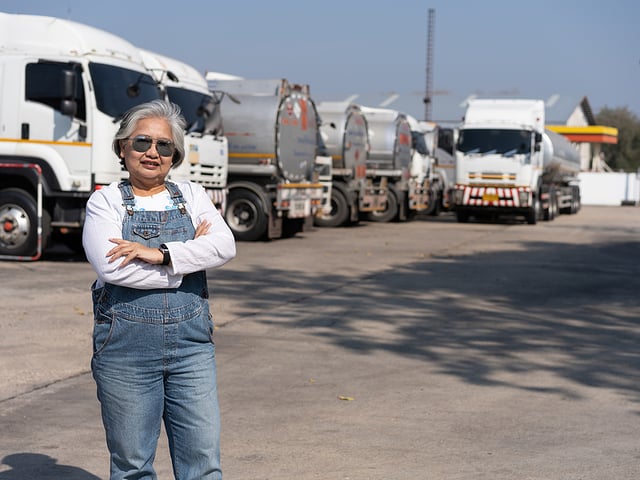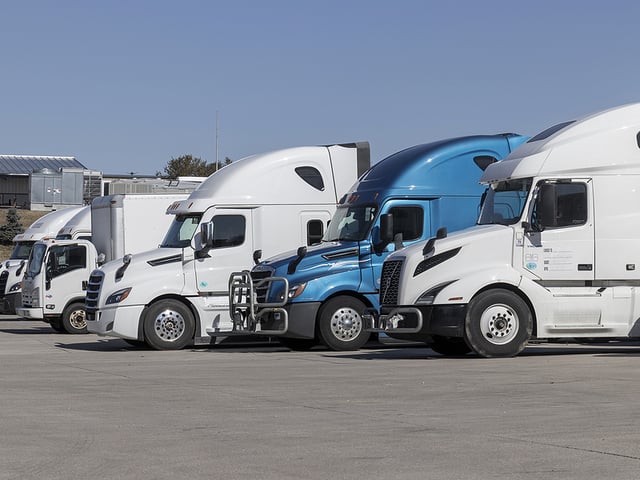
How Much Does It Cost to Get a CDL?
The trucking industry dominates freight shipping. Trucks handle over 70% of U.S. goods and rake in over $700 billion in revenue.
There are nearly 1 million carriers currently hiring truck drivers across the country. Are you interested in a trucking career? Are you unsure how much it will cost to get started?
The exact expense depends on tuition rates, state fees, and other factors. Our complete CDL guide goes over all the basics so you can accurately determine the cost to get a CDL in your state.
Why Apply for a CDL?
Do you want to skip the routine office life where you stare at the same four walls every day? A Commercial Drivers License allows you to find a career where new sights and scenery are right in the job description.
A CDL is required anytime you drive large and heavy vehicles for commercial purposes. This includes everything from local delivery trucks to big rigs traveling across interstates.
It’s also necessary for hauling hazardous material. This means goods like flammables, infectious substances, and compressed gases.
Your CDL license comes with many benefits. These can include:
-
Career stability
-
Job variety
-
Flexible schedules
-
Travel (in-state or cross-country)
-
Comprehensive benefits (medical, dental, etc.)
-
Life insurance
-
Paid holidays and vacations
-
College tuition programs
Getting your CDL is generally faster and cheaper compared to a college degree or trade-school certification. You can also start trucking jobs right away without $30,000 to $40,000 in student loans hanging over your head.
Cost to Get a CDL
What is the exact cost of a CDL? Unfortunately, there are too many variables for one answer. CDL prices include:
-
Commercial Learner’s Permit (CLP) costs
-
Training course tuition price
-
Skill and knowledge test prices
-
Application fees
-
License fees
-
Your license classification
-
Any added endorsements
-
Misc. vehicle expenses (if one isn’t provided)
Generally, you can expect to pay anywhere between $1,500 to $10,000 for CDL tuition. This will be your highest expense overall.
You don’t have to start stocking up on cheap ramen noodles just yet, however. Trucking schools generally understand not everyone has a few thousand laying around to drop on a CDL course.
There are many reimbursement and finance options available. Some carrier companies even offer finance and hiring programs along with training.
CDL Basics
It’s important to know all your CDL basics in order to accurately determine CDL prices. You may pay for a more expensive Class A training program, for example, when all you needed was a Class C license.
License Classes
CDL license class depends on the weight and size of your commercial vehicle(s). There are three main CDL classifications:
-
Class A
-
Class B
-
Class C
Class A is required for the largest and heaviest trucks. This includes 18-wheelers and livestock carriers.
Class B is for vehicles that aren’t pulling tractor-trailers. This includes large and/or segmented buses, delivery vehicles, and dump trucks.
Class C is for all other commercial vehicles outside of Class A and B weight requirements. This includes any vehicle that carries 16 or more passengers or hazmat freight.
Class A courses can be more expensive depending on your training program. For example, the California Truck Driving Academy charges $6,500 for a Class A program and $4,000 for a Class B.
The A classification is universal, however, and covers all other classes. You won’t need an additional B or C license with a Class A.
Endorsements
Every state manages its own endorsement requirements. However, there are 6 federal endorsements every state must observe:
-
T: Double and triple trailers
-
P: Passenger
-
N: Tank vehicle
-
H: Hazardous materials
-
X: Tank vehicle and hazmat combo
-
S: School bus
Endorsements can add extra fees to your course and licensing. Washington state charges between $37 and $156 to add CDL endorsements, for instance.
Restrictions
There may be certain restrictions on your license as well. This means you cannot drive certain vehicles. There are 7 federal restrictions:
-
L: No full air brakes- test procedure failures
-
Z: No full air brakes- tested with an air-over-hydraulic system
-
E: No manual transmission- tested with an automatic
-
O: No fifth wheels- tested without fifth wheel connection
-
M: Class A license restricted to Class B or C passenger vehicles and school buses
-
N: Class B license restricted to Class C passenger vehicles or school buses
-
V: Medical variances issued to the driver
Restrictions generally don’t cost extra, but you may have to pay more to avoid or take it off your license. This may include retesting and/or renewing your existing CDL. In Oregon, for example, the removal of an air brake restriction includes a $61 replacement license fee.
Getting a CDL
Obtaining your CDL includes basic requirements and following the state procedures outlined in their CDL manual. There are three main steps to getting a CDL:
-
Obtain your CLP
-
Take an approved CDL course
-
Take the official state CDL licensing tests
You can only test in your state of residency, and you can only have one state CDL license at a time. You must surrender your old CDL before being issued a new one in another state.
Having a CDL in more than one state is punishable by fines. This prevents people from hiding license violations, convictions, or suspensions between states.
Basic CDL Requirements
Every state has its own CDL requirements. Some states are stricter than others. No state can go lower than the federal minimum, however.
Basic federal requirements include:
-
18 years of age (in-state travel) or
-
21 years of age (out-of-state travel)
-
Proof of citizenship or lawful residency
-
Proof of state residency
-
Valid state driver’s license
-
Medical certification
-
Background check
You can also be disqualified based on certain medical conditions or criminal convictions. You can receive a lifetime CDL disqualification, for example, if you’re convicted of using a vehicle for human trafficking or drug trafficking-related offenses.
Obtain a CLP
The CLP is a federal requirement. The Federal Motor Carrier Safety Administration (FMSCA) requires drivers to hold a CLP for at least 14 days before taking the CDL test.
Drivers must also pass approved Entry-Level Driver Training (ELDT) before testing. In February 2022, FMSCA issued new EDLT requirements to standardize CDL procedures.
Every state has its own CLP requirements. The federal minimum includes:
-
Be at least 18 years old
-
Have proof of citizenship or lawful residency
-
Possess a valid state driver’s license
-
Pass a general knowledge test
The CLP allows you to drive in your training course with a valid driver present. Without a CLP, you cannot pass the CDL’s skills test portion.
Like CDL prices, CLP fees vary by state. CLPs are generally cheaper. For instance, Kansas only charges $13 for their CLP application fee, compared to $41 for a CDL (without endorsements).
Take an Approved CDL Course
Training programs are managed by your state. However, they must be approved by FMSCA to be valid. FMSCA maintains a training provider registry so you can look up approved schools in your area.
There are three main places that provide training programs:
-
Community college programs
-
Private trucking schools
-
Commercial trucking companies
Each training program offers benefits that may or may not be right for you. This includes cost, length of time, schedule, and other factors.
Community college programs, for example, are generally longer than commercial and private schools. But they can also be much less expensive and offer more tuition payment options.
Make sure to research your training program options thoroughly before making a commitment. Private or commercial trucking schools should have a solid reputation and student hiring success rate. College programs should be through state-accredited schools, which is different from FMSCA approval.
Take the Official CDL Licensing Tests
Just like a regular driver’s license, you will have to pass two tests: a written test and a practical skills test. CDL prices for testing are determined by the state.
You may take the knowledge test through your training school or an official state licensing center, such as a DMV. The skills test must be administered through the state, however, according to current regulations.
Passing the CDL Tests
Reckless and uninformed driving is a huge safety hazard, especially in larger and heavy vehicles. Passing the CDL tests proves you know how to handle these vehicles.
You can find test fees through your training program, local DMV, or state government website. For example, New York charges $40 for the skills test and each subsequent re-take if you fail to pass it.
The training courses come with a hefty price tag, so do your best to pass. You may end up paying extra time and money for repeated test failures.
Fortunately, there are many online resources to help you pass the knowledge test:
-
Study guides
-
Flashcards
-
Cram courses
Failure to observe proper procedures or identify important mechanical components can result in a re-test. You may only get one or two re-tests before you have to start over again on training and costs. So take advantage of the comprehensive courses and study guides!
Knowledge Test
The knowledge test is tough to pass without proper study. You must remember information with quick accuracy. This test is actually made up of several different subtests. This includes a General Knowledge test and an Air Brakes test.
The General Knowledge test includes vehicle inspections and driving procedures. It also tests your ability to transport cargo, including inspecting and securing it properly. You should also know how to respond to difficult road conditions, such as inclement weather and steep terrain.
The Air Brakes test is required to drive a vehicle equipped with an air brake system. It includes system parts, brake inspections, and proper brake operation. You may want or be required to have certain endorsements. There are five endorsement tests available:
-
School bus
FMSCA requires a minimum score of 80% to pass the General Knowledge and endorsement tests. Some states offer the tests in other languages. Washington state, for example, offers the written tests in Spanish, Russian, and Serbian–Croatian versions.
Skills Test
The skills test will include study and practice. Like the knowledge test, you should prepare effectively so you don’t end up failing and retesting.
The skills test includes three basic parts:
-
Vehicle inspection
-
Basic controls test
-
Road test
These tests can be very strict, so bring your A-game. Some states will end the entire test the moment you fail the initial vehicle inspection, for example.
This test is also required in English. You won’t be able to use an interpreter or test in another language.
You should not attempt the skills test until you are absolutely ready. Some training programs go very fast, especially in private schools. If you need time to get comfortable with large vehicles or sharpen your English proficiency, make sure to choose schools with the accommodations you need.
Military members who meet certain requirements can receive a skills test exemption. Contact your local DMV to learn more.
Apply for Your License
You can generally check your state’s .gov resources to find out applicable license fees. Below are links to licensing fees by state:
- Alabama
- Alaska
- Arizona
- Arkansas
- California
- Colorado
- Connecticut
- Delaware
- Florida
- Georgia
- Hawaii
- Idaho
- Illinois
- Indiana
- Iowa
- Kansas
- Kentucky
- Louisiana
- Maine
- Maryland
- Massachusetts
- Michigan
- Minnesota
- Mississippi
- Missouri
- Montana
- Nebraska
- Nevada
- New Hampshire
- New Jersey
- New Mexico
- New York
- North Carolina
- North Dakota
- Ohio
- Oklahoma
- Oregon
- Pennsylvania
- Rhode Island
- South Carolina
- South Dakota
- Tennessee
- Texas
- Utah
- Vermont
- Virginia
- Washington
- West Virginia
- Wisconsin
- Wyoming
Once you pass, congratulations! You’re ready to apply for an official CDL.
It’s Time to Start Pulling Your Freight!
A CDL license opens up many exciting new jobs and career opportunities. The exact cost to get a CDL can be tricky, but now you have the knowledge you need to make informed decisions about the factors that will affect your CDL prices.
Are you ready to ace your CDL test? We offer all the best study tools for success– sign up for your free account today!
Keep Reading

Commercial Driver's License Test Blog
How Many Questions are on the CDL Permit Test?
Embarking on a career in commercial truck driving begins with a crucial…

Commercial Driver's License Test Blog
What are the Three Tests for the CDL Permit?
If you’re looking to embark on a career in truck driving, obtaining a C…

Commercial Driver's License Test Blog
The CDL Manual by State: Everything You Need to Know
Are you ready to average over $81,997 per year with numerous career and…